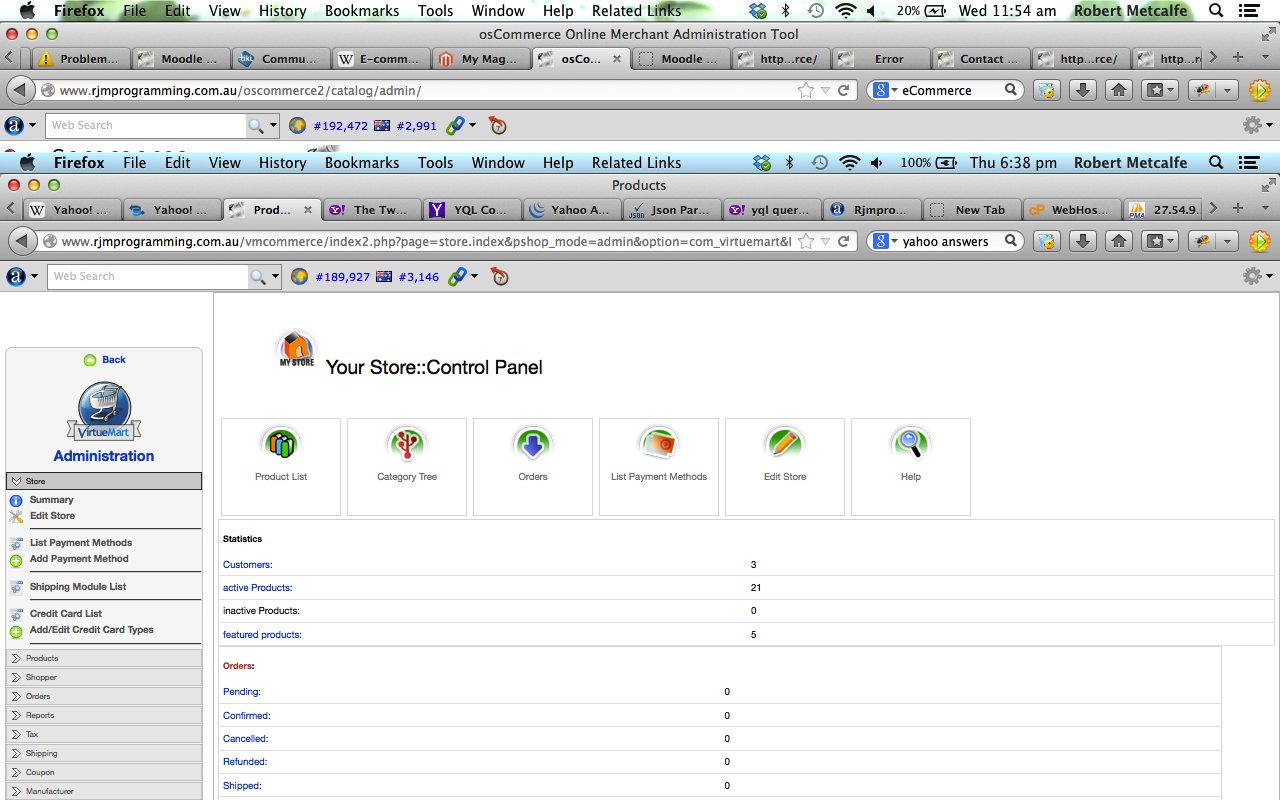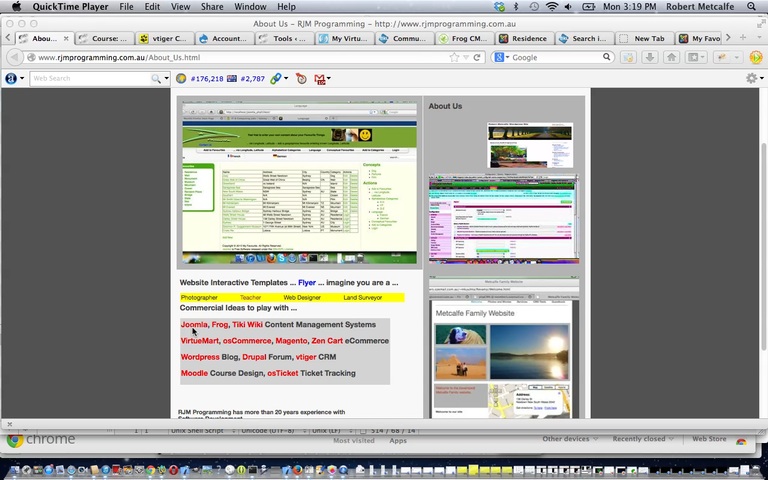Here is a tutorial that introduces you to eCommerce as an “out of the box” solution, should you, as a business, be heading that way. Earlier we talked a bit about CMS in the same way with Content Management System Primer Tutorial as shown below. Let’s have a look at how Wikipedia defines eCommerce:
Electronic commerce, commonly known as e-commerce or eCommerce, is a type of industry where the buying and selling of products or services is conducted over electronic systems such as the Internet and other computer networks. Electronic commerce draws on technologies such as mobile commerce, electronic funds transfer, supply chain management, Internet marketing, online transaction processing, electronic data interchange (EDI), inventory management systems, and automated data collection systems. Modern electronic commerce typically uses the World Wide Web at least at one point in the transaction’s life-cycle, although it may encompass a wider range of technologies such as e-mail, mobile devices, social media, and telephones as well.
Electronic commerce is generally considered to be the sales aspect of e-business. It also consists of the exchange of data to facilitate the financing and payment aspects of business transactions. This is an effective and efficient way of communicating within an organization and one of the most effective and useful ways of conducting business.
The way you might differentiate the quality of eCommerce platforms is via:
- Does the eCommerce programming language and database agree with the hosting requirements?
- Given databases of the same size which eCommerce website runs faster (the world gets more impatient, but the data keeps accumulating)?
- How good is its content editing?
- How easy is it to tailor to your own requirements?
- How good is its third-party add-ons and plugins support?
- How good is its product support?
- What content form is allowed (eg. blogs, forums, pages)?
- What content type is allowed (eg. images, videos, audios)?
- How friendly are its SEO principles?
- How good are the controls for user functionality and restrictions?
- How good are its payment gateway arrangements?
- How good is its account reporting functionality?
- How good are its subsidiary marketing tools (eg. social media, subscriptions, feeds)?
- How mobile-ready are the websites/mobile apps it produces?
- How efficient is its Administration backend maintenance functionality?
- If website involves monetary transactions, is SSL supported?
- Is there good support for website security related plugins and/or addons or other software maintainance?
Stop Press: VirtueMart Joomla eCommerce version needed updating for PHP 5.4 (which was needed to get a gzip/mod_deflate speed improvement implemented as per WordPress Blog PHP mod_deflate Speed Improvement) and this happened on 24/3/2015, where we upgraded to Joomla 2.5.28. Here is a link to the new version of sample data VirtueMart.
Let’s see our tutorial stream of consciousness view of the Administration view of the eCommerce product called VirtueMart (powered by Joomla CMS using PHP and MySql). Please note the product has come on, in versions, from the one presented here, and so, with this in mind, we won’t dwell on payment gateway functionality during the tutorial (though you should find out a lot about the eCommerce website product’s facilities, here, when choosing a product … PayPal is a big player here), but instead, think of it as a stream of consciousness, test drive, and what to expect type of tutorial.
The tutorial shows the Administration area of the VirtueMart website. Often the term “backend” is applied to websites and this can variously be thought of as, in its narrow view, the database and its structure and design and maintenance, and in the wider view, this Administration section of an eCommerce website, where it is maintained, and has that interface to the database and the “frontend” (the products and marketing material) presented as a shop catalogue to the web user. This Administration “backend” is never designed to be accessible by unregistered users nor your normal shopping user, and is maintained, normally, by users with administrative priviledges.
Link to eCommerce information via Wikipedia from which the above quote comes.
The VirtueMart product is a PHP/MySql product and you can compare and contrast it with other eCommerce products (and CMS ones) here at this domain. With the emphasis on PHP eCommerce above it does not mean that there are not excellent ASP.NET eCommerce in the marketplace.
Please see CMS tutorial of relevance, too, Content Management Systems Primer Tutorial, as shown below.
Here is a tutorial that introduces you to Content Management Systems, or CMS. Let’s have a look at how Wikipedia defines CMS:
A Content Management System (CMS)[1][2][3] is a computer program that allows publishing, editing and modifying content as well as maintenance from a central interface. Such systems of content management provide procedures to manage workflow in a collaborative environment.[4] These procedures can be manual steps or an automated cascade. CMSs have been available since the late 1990s.
CMSs are often used to run websites containing blogs, news, and shopping. Many corporate and marketing websites use CMSs. CMSs typically aim to avoid the need for hand coding, but may support it for specific elements or entire pages.
There are a lot of CMS in the web marketplace as you can imagine, and there is overlapping relevance with eCommerce websites and CRM (Customer Relationship Model) websites. This is because these are all ideas asking for customers to be involved and interactive with commercial (or personal) websites.
The thing about CMS is that it is a very mature concept now, having been around for some time, and there is often an assumption in the marketplace that when you do shopping online, there will be a chance for interactivity, whether that be during the purchasing of products, or even email contact, or giving feedback. CMS has a major role to play, particularly with feedback, and/or with efforts by the website owner to understand their customer requirements. So, another area of overlap is with SEO (Search Engine Optimization), which is the study of getting your website noticed with the big Search Engines (like Google, Bing, Yahoo). CMS products have been refined out-of-the-box, and with third-party plugins and add-ons to be more attuned to successful attraction of web traffic via SEO principles.
The way you might differentiate the quality of CMS platforms is via:
- Does the CMS programming language and database agree with the hosting requirements?
- Given databases of the same size which CMS website runs faster (the world gets more impatient, but the data keeps accumulating)?
- How good is its content editing?
- How easy is it to tailor to your own requirements?
- How good is its third-party add-ons and plugins support?
- How good is its product support?
- What content form is allowed (eg. blogs, forums, pages)?
- What content type is allowed (eg. images, videos, audios)?
- How friendly are its SEO principles?
- How good are the controls for user functionality and restrictions?
- If website involves monetary transactions, is SSL supported?
- Is there good support for website security related plugins and/or addons or other software maintainance?
Let’s see our tutorial stream of consciousness view of CMS.
Link to CMS information via Wikipedia from which the above quote comes.
With the emphasis on PHP CMS above it does not mean that there are not excellent ASP.NET CMS in the marketplace, and would like to direct you to Mojo Portal as one example, but there are many others.
If this was interesting you may be interested in this too.
If this was interesting you may be interested in this too.




